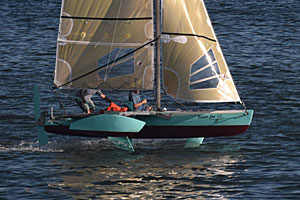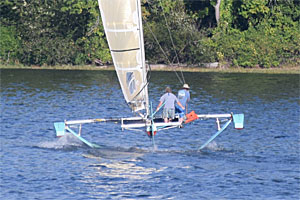

Jim's home | Trimaran home | This boat's home
Generally the drill is, you detach from the mooring or launch from the beach after hoisting sails. Get the short rudder down for steerage. Move downwind from where I live on my bay to deeper, wider water. Point into the wind, then get the short rudder pulled up and the t-foil rudder pulled down. Then run over to each of the main foils' controls and get those foils deployed ("get the boards down"). Then run back to the helm to regain control. A second person helps in this. Then you can try to foil.
Where I live on Liberty Bay in Poulsbo, WA, summer northerlies often blow between 10 and 15 mph. Those are the winds I designed this boat for, and indeed it would foil in those winds. I've foiled by myself plenty of times when there were no whitecaps. So you trim your sails for a broad reach and go hunting for gusts. When one hits you move to the back of the boat to increase the angle of attack on the foils (they're about 3 or 4 degrees by default). If the gust holds then boat gets all squirrley. It feels slightly unstable. Then you watch the waterline recede on the foils and the sides of the hulls. Once you're out of the water it accelerates rapidly. Then quickly move forward to level out the boat. Then move wherever you have to, quickly, but in small movements, to keep the boat level fore-aft and side to side. I would often stay standing, steadying myself by hanging onto the mast shrouds with one hand with the tiller in the other.
I know you're suppose to uncleat the main when things get hairy, but it's all I can do to steer the boat and keep it level. So I'd just cleat it and point higher if the wind picks up. I usually didn't care where I was going, so that wasn't an issue. A second person helps safety-wise in being able to depower the jib if needed. It took quite a few sessions of sailing by myself to get over the fear factor and carefully adjust my course to maintain level flight. But what thrill when you're foiling. The water gets lower as you rise, the boat gets quieter until it starts to hum.
I never made a foiling jibe or tack on it. Been about half way around a jibe on a foil, then came down. It's pretty terrifying trying to do a foiling jibe. You have to have a lot of speed 16+mph going into the jibe and trust that you won't crash or pitchpole midway through the jibe.
Liberty Bay gets pretty crowded in the summer, so foiling usually meant threading the needle through moored boats. Scary not having much room to manuever.

